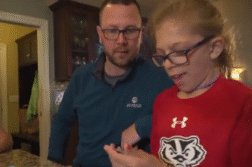Pediatric endocrinologist at Washington University in St. Louis, Dr. Jennifer Sprague, talks about new guidelines from the American Academy of Pediatrics about battling obesity in children.
Interview conducted by Ivanhoe Broadcast News in 2023.
Can you tell me about the obesity epidemic affecting young people?
SPRAGUE: The rates of obesity have been increasing over many years. They started to rise in the 1980s and ’90s and now about 20% of our pediatric population today is obese.
Wow, 20%. What do you think has caused the increase?
SPRAGUE: There are so many factors involved. Factors contributing to obesity include things that we can’t change such as genetics, parental interactions, and things that happened during pregnancy. However, environmental factors play a role in this as well as our social determinants of health. Kids now walk less and spend more time on screens. The food environment has changed so that food is much more processed. The cities they live in and the environment they’re exposed to also contribute to what’s causing obesity.
Up until now, were there any guidelines on what to do for these children?
SPRAGUE: There have been no true guidelines. There have been statements made acknowledging what we already knew about the impact of lifestyle interventions, but this is the first true guideline that we’ve been given.
What do these guidelines entail?
SPRAGUE: They include information on how to diagnose obesity factors that are influencing the development and maintenance of obesity. They also discuss how to screen for different problems that arise in kids who have obesity. Treatment options including lifestyle and behavioral interventions are discussed as well as medications and surgical options for the treatment of obesity.
Would you consider these guidelines a game changer for pediatric obesity?
SPRAGUE: It definitely serves as an easily accessible document for pediatricians and other people who take care of kids. It recognizes that obesity is a chronic disease. You don’t have obesity one day and then you suddenly cure it overnight. This is something that many of these kids are going to be dealing with for the rest of their life. The new guidelines highlight that a watch and wait strategy is not effective. If you interact with a kid who has obesity and you give a little bit of guidance and you just see how it goes, most of the time things don’t get better. This guideline encourages us to offer all of our treatments as soon as a patient is eligible for them, meaning behavioral treatments and also talking about medications and surgery at first interactions potentially.
If these kids aren’t helped before the age of 12, and they’re now morbidly obese on the scale, is their life expectancy cut down by 20 years?
SPRAGUE: Well first, I don’t like the term morbid obesity.
Why?
SPRAGUE: Obesity is a really stigmatizing disorder. People have strong emotions. There’s a lot of stigma around certain patients and insensitive labeling often happens due to their condition – “they’re lazy, they’re not smart”. When you hear those words, people internalize them and they think badly of themselves. Which is why I don’t want to use morbidly obese. We will clinically refer to a patient with obesity, but I really prefer to try and use patient first terminology. Using phrases like “obese patient” and “morbid obesity” just has a very negative connotation. Sorry, I took us off track.
No, that’s great to know. I’ll refrain from using that term. Is it permissible to use that wording when diagnosing someone?
SPRAGUE: I never code it as morbid obesity. I’ll code it based on BMI and I’ll code severe obesity, but I’m categorizing the severity of the disease. I really dislike morbid obesity.
Is this topic, the importance of sensibility, something we’ll find in the guidelines?
SPRAGUE: There is discussion of being aware of your terminology and all the emotional implications and the stigma that relates to having obesity in these guidelines.
Excellent. I’m curious to learn of the trials that comes with obesity when not handled at a certain age. Can you tell us more about that?
SPRAGUE: There is data that shows having obesity as an adolescent and continuing to gain weight, increases your risks of getting other chronic diseases related to obesity over time. There’s also data that shows if you have a decreasing weight from adolescence into young adulthood then some of the risks go down. I wouldn’t say there’s a “we have to catch you at this exact point and if we don’t catch you, then there’s no hope” period. I think there’s always hope that if you treat this disease you’re going to lessen the long-term consequences. The earlier you catch it potentially lowers certain health risks for these patients.
Do you think these guidelines came about because of the surgence of doctors performing gastric bypass and lap band surgery on young people? As well as the drugs being produced?
SPRAGUE: I think the timing is maybe coincidental. We’ve gained a lot of knowledge from many studies about behavioral interventions. We do have a lot of new drugs that have come out in the last couple of years that really have a big impact on weight. We’ve also gained a lot of knowledge about the effectiveness of bariatric surgery in adolescent populations, not really lap bands, mostly it’s gastric sleeves and some are Roux-en-Y (gastric Bypass). Lap bands have mostly fallen out of favor.
There is a diabetes drug that’s all the craze among celebrities as of late, is that something acceptable to give to kids?
SPRAGUE: I think you are referring to “semaglutide” which is the drug’s generic name. The brand name is Ozempic or Wegovy depending on the formulation. That drug has been FDA approved in adolescence as Wegovy (the weight-loss formulation) as of December 2022. There are kids taking that medication.
Considering the guidelines, how do you think that’s going to impact the board?
SPRAGUE: I think pediatricians are going to have a lower threshold for intensifying their treatment and considering medications and considering referral to surgery. I think there’s still a lot of barriers to get patients the treatments that they need. The availability of really intensive behavioral programs is limited. Insurance coverage of those programs is limited. We still have a lot of work to do to make those available both in physician offices and in community-based interventions. Insurance is also another barrier that prevents us from giving our patients the treatment that we really think they would benefit from. We may not be able to get those medications because insurance often says we don’t pay for any medications for weight loss. You have to have already developed a co-morbidity of complication like diabetes before they’ll cover a medication. Surgery may also not be covered.
Do you think these guidelines will help change that with the insurance?
SPRAGUE: One would hope that these guidelines will begin to change that insurance landscape. Hopefully it will increase coverage for behavioral interventions, medication, and surgical options. They can make a really huge difference in patient’s lives.
You mentioned behavioral interventions, what is that?
SPRAGUE: Behavioral interventions help change how people approach their physical activity. It’s self-management. They’ll learn about goal-setting and they’ll learn about how to work to overcome barriers that they have in their own lives and work within the environments that they have. That can be an intervention in a doctor’s office. It can be an intervention in a community program like a YMCA or some other outreach program. It can be one-on-one, it can be a group. Really what it comes down to is frequent interactions with whoever is leading these interventions. Family based interventions have proven to be most effective and the guidelines encourage greater than 26 hours of contact with the patient.
Okay, let’s speak on Type 2 Diabetes for a moment. It seems the prevalence of this disease has soared in recent years. Have you seen this to be true in our youth?
SPRAGUE: Type 2 diabetes in youth has skyrocketed over the last 10-20 years. It was pretty rare before the obesity incidents went up so much. Now it’s almost as common that we diagnose Type 2 diabetes as it is Type 1, at least I feel like it’s almost as common in the hospital.
But it’s one of the most preventable diseases, right?
SPRAGUE: Yeah. Type 2 diabetes is very rare in children and adolescents who don’t have obesity. If we could focus on the prevention of obesity or curing obesity, then the hope is that alarming diseases, like Type 2 diabetes, won’t be contracted.
END OF INTERVIEW
This information is intended for additional research purposes only. It is not to be used as a prescription or advice from Ivanhoe Broadcast News, Inc. or any medical professional interviewed. Ivanhoe Broadcast News, Inc. assumes no responsibility for the depth or accuracy of physician statements. Procedures or medicines apply to different people and medical factors; always consult your physician on medical matters.
If you would like more information, please contact:
Judy Martin Finch Diane Duke Williams
martinju@wustl.edu williamsdia@wustl.edu
Sign up for a free weekly e-mail on Medical Breakthroughs called First to Know by clicking here




